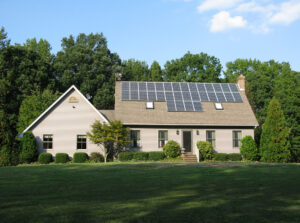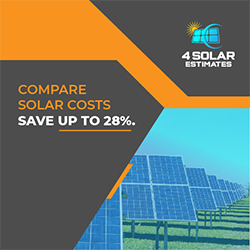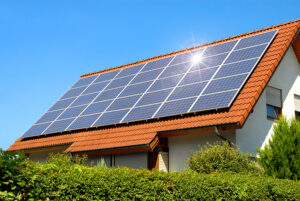How Much Does Solar Panel Installation Cost? Compare Prices by Sq. Ft.
From the number of panels to the power output, a lot goes into calculating the cost of a solar panel installation per square foot. We’ll tell you everything you need to know.
Solar panel installation costs have dropped nearly 70% in the past ten years. Nearly five percent of homes nationwide have transitioned to solar energy, and the percentage is expected to triple by 2030. Let’s talk about what you can expect to pay for solar installation.
Solar Panel Installation Costs by kW (kilowatt-hour)
| Solar Panel kWs | Average Costs Installed |
|---|---|
| 2 kW | $5,800 – $6,300 |
| 3 kW | $8,999 – $9,545 |
| 4 kW | $11,778 – $12,305 |
| 5 kW | $13,999 – $14,903 |
| 6 kW | $17,700 – $18,750 |
| 7 kW | $20,760 – $21,428 |
| 8 kW | $23,499 – $24,800 |
Is Solar Worth It?
Even though prices for solar panels have significantly dropped, you may wonder if the cost to install solar panels is worth it. You need to consider the cost of solar panels, labor fees, other equipment, and the difficulty of your roof. The last thing you want to do is install solar panels on the wrong side of your roof or install too few solar panels to make a difference.

At 4SolarEstimates.com have all your solar panel questions answered in this complete guide, including costs, incentives, and more. Keep reading for more information.
National Average Cost of Solar Panels
| National Average Cost | $23,000 to $35,000 |
| Lowest Cost | $14,500 to $19,750 |
| Highest Cost | $50,000 to $65,000 |
What Are Solar Panels?
You have likely heard of solar panels as they have become more prevalent in recent years, but what are they, and why are many homeowners turning towards them? Sun generates energy, and solar panels utilize this natural source to help power homes, businesses, and the world around you.
They do this by converting the sunlight through panels or mirrors. These specialized equipment channels the radiation and either directly powers your home or can be put in storage batteries for later use. There are two main types of solar technology:
- Photovoltaics (PV)
- Concentrating solar thermal power (CSP)
PV systems are likely the more popular versions you’ve seen in your neighborhood. A PV system uses solar panels that absorb the sun’s radiation and creates an internal electrical field. CSP systems use mirrors instead of solar panels and are more commonly seen in industrial businesses.
COMPARE COST BY SQ FT:
Solar Panel Installation Factors
When considering installing solar panels, you’ll need to factor in what type of home you have. First, check out your roof and see what slopes get the most sunlight. These will likely be roof slopes that face the west or south.

You may consider trimming them back for more direct sunlight if you have large shade trees. You can install solar panels on the ground, but the most common residential setup is on the roof.
Solar panels can still generate some electricity during cloudy days, but they won’t be as effective as bright and sunny ones. Although, you don’t need heat. This makes solar panels great options for any state, but you’ll want to consider how many days of sunshine your region gets.
Residents that aren’t in a sunny region can still pull energy from power grids and supplement sunnier days with solar usage, which can continue to lower costs. Remember, solar panels are installed onto your roof. If you have an outdated roof that will need to be replaced soon, you should tackle that home project first.
National Average Cost of Solar Panels per Watt
Determining the solar cost per watt requires a simple calculation. Most systems and costs are outlined in kW.
To convert into wattage, multiply that number by 1,000. Next, follow these steps:
- Determine gross system cost (excluding rebates)
- Divis gross system cost by the total wattage
- Compare your cost per watt
A few different factors can increase your costs per watt, such as fixed installation costs and extra fees. Extra fees could include added installations, such as:
- Electrical work
- EV chargers
- Steeper roofs
Your roofing material type can also play a factor, including Spanish clay, metal, or even flat roofs. It is dependent on your contractor, the distance traveled, and their set charges, so ask ahead of time.
Smaller systems will average higher costs per watt. For example, a 5kW system will likely range between $3 to $5 per solar watt since the contractors and installers have to move the equipment and materials out to your house. A more extensive system, such as a 10 kW, may range less than $3 per watt.
National Average Cost per Solar Panel
Determining how many solar panels you need comes down to a few factors:
- How much electricity do you want to be covered?
- Roof/space availability
- Budget
Most experts suggest a single solar panel will cost between $225 to $375. Even ten solar panels can quickly increase to thousands of dollars.

Luckily, most panels last a decade or two with proper care and can reduce monthly energy expenses. Checking your panels after storm systems and having professional maintenance teams come out and inspect them can save you money in the long term.
Other cost-saving measures include tax incentives and rebates if you choose to fork out the cost of going solar.
How Many Solar Panels Do You Need?
The average electrical consumption for a residential home in the United States is over 10,700 kilowatt-hours (kWh). If you break that number down monthly, it is around 890 kWh or 29 kWh daily. Your energy consumption, housing size, and where you live can all contribute.
If you take that 890 kWh, you can easily calculate how many solar panels you need to cover your entire electricity. The type of solar panel can affect this number, and getting an estimate from a local solar panel installer will give you the most accurate measures.
An average solar panel can range from under 200 watts per hour to almost 350 watts of electrical output. Going back to our math, you can divide that number by 1,000 and get a kWh range. It will pop out as approximately 0.2 to 0.35 kWh.
The math becomes a bit trickier as you’ll need to determine how many hours of sunlight and days of sunlight you can average. You can track this yourself or go off estimates for 20 to 25 panels. Here are some other factors that can increase how many solar panels you need:
- Square footage
- Higher monthly energy consumption
- Fewer sunny days
- Solar panel selection
Talk with your solar panel installation company about the type of solar panel that works best in the region you live in and your home.
Is Solar Installation Worth It?
Installing solar panels is a decision that you requires careful consideration, especially where you live. Sunnier states like Arizona, southern Utah, and California can be no-brainers. But if you live in northern regions, you may wonder if there is enough sunlight to offset the prices.
One of the most significant incentives is the federal solar tax credit. Federal tax credits can reduce the total amount you owe in federal taxes at the end of the year. Your total cost of installing a solar panel system falls under this classification.
So just how much can you save?
At the end of 2020, Congress extended this tax credit. Any solar panel systems installed between 2020 and 2022 can receive a 26% federal tax credit.
Systems installed in 2023 qualify for 22% credit. What is included in the ‘overall cost’?
- Cost to install solar panels
- Number of solar panels
- Other equipment (e.g., wiring, mounting systems)
- Storage devices
The Office of Energy Efficiency and Renewable Energy gives an example that can help you see how much you can save. If solar panels cost $18,000 to install, you could multiply that number by 0.26.
Your final savings at the end of the year would be over $4,600. If you received state rebates, you’d first have to subtract that from your total cost. Currently, there aren’t plans to renew this tax credit incentive for 2024, so now is an excellent time to find a solar panel installer.
Which States Have the Best Solar Rebates?
Most sunny states have great state rebates that can help you reduce your costs even more. Arizona is one of these states with a 25% Residential Solar Tax Credit.
It stops after $1,000, but still – it is better than nothing! Here are some more states with excellent solar rebate incentives:
- California
- Colorado
- Massachusetts
- New Mexico
- New York
- Oregon
- South Carolina
- Utah
The different rebates and incentives to watch out for are tax credits, low-interest loans, and property tax relief. Most states can work in conjunction with federal tax credits, so you can save a lot of money by doing your research first.
How Much Money Can Solar Panels Save You?
On average, you can save one cent per kWh by pulling energy from a solar panel grid. Some homeowners use solar panels full time, reducing their monthly energy costs to zero.

You can sometimes receive energy credits if you contribute to the solar panel grid. Solar panels can also reduce the amount of energy you use as you become more conscientious of home energy usage. States with higher energy costs provide even more incentive to switch to solar, and they can pay themselves off within a couple of decades.
You could also increase your home’s value if you are looking at putting it on the market.
Other Fees to Consider
| Service/Product | Cost / Fees |
|---|---|
| Labor and Time | $0.29 – $0.31 per watt |
| Solar Panels | $0.45 – $0.48/Wdc |
| Inverters | $0.11/Wdc – $0.38/Wdc |
| City Permits | $0.06 – $0.07/Wdc |
| Structural BOS | $0.09 – $0.11/Wdc |
| Electrical BOS | $0.17–$0.30/Wdc |
| State sales taxes | 5.5% -8.0% |
| Electrical Installers | $45.00–$95.00 per hour |
| Laborers | $14.00–$25.00 per hour |
| Burden rates | 29.0% – 33.0% |
Finding a Solar Panel Installer Near You
Have you wondered if a solar panel installation is suitable for your home? Many cost benefits and incentives can make solar a great option. It is also an environmentally-friendly option that helps support green energy sources, and it can boost your home’s value.
Since there are many considerations for a new solar panel installation, you need an expert installer to give you price quotes and provide an in-person assessment. Check out our website to find a solar panel installer near you!
